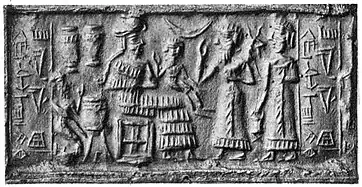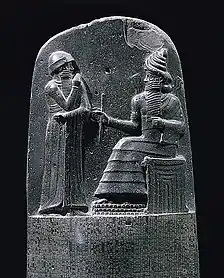Adab (gesture)
Adab (Hindustani: آداب (Nastaleeq), आदाब (Devanagari); Bengali: আদাব), from the Arabic word Aadaab (آداب), meaning respect and politeness, is a hand gesture used in the Indian subcontinent, by the Urdu-speaking and Bengali-speaking Muslim population while greeting, as well as many non-Muslims (Hindus and Christians) in north India.[1][2] It is associated with the Ganga-Jamuni culture of South Asia, especially of the Urdu-speaking communities of Uttar Pradesh, Hyderabadi Muslims, and Muhajir people of Pakistan and Bengali-speaking Muslims of Bangladesh.[3] It (Adab) is widely used in the rural (villages) area of Bangladesh, in order to alternate Salam to Non-Muslims, especially Hindus.

History


Adab greeting probably dates back to Bronze age period, a prominent Mesopotamian greeting involved bending right arm at the elbow and raising hand before the face which was a well known gesture of pious greeting, it is depicted in Code of Hammurabi, Ur III seal etc, it also finds literary mention in Sumerian verb ''kiri šu-gal'', Lit: 'to let the hand be at the nose' [4], a similar gesture is seen in Indus Valley Civilzation seals and various historic period Indian arts for instance chandraketugarh plaque, Begram ivories etc.
Since the religious greeting of Muslims i.e. "Assalamu Alaikum" was meant for Muslims only,[5] and Muslims in India lived in a multi-faith and a multi-lingual society, this alternative form of greeting was coined. Its use became so pervasive in the high culture of northern and central India that it was not considered inappropriate to reply to 'salaam' with 'aadaab' and vice versa and it was used frequently in non-Muslim households as well.[1] The use of Aadab is especially popular in the Indian city of Hyderabad, where religious pluralism has been historically emphasized; the Nizam of the region stated: "Hindus and Muslims are like my two eyes ... How can I favor one eye over the other?"[6] In some localities of India and Pakistan, the phrase and gesture has decreased in use because it is perceived as insufficiently Islamic compared to other greetings, though it is preferred by many who still use it due to its inclusive nature.[1]
Description
The gesture involves raising the right hand towards the face with palm inwards such that it is in front of the eyes and the finger tips are almost touching the forehead, as the upper torso is bent forward.[7] It is typical for the person to say "adab arz hai" (Nastaleeq: آداب عرض ہے, Devanagari: आदाब अर्ज़ है), meaning "I offer my respects to you", or simply just "aadab".[6] It is often answered with the same or the word "tasleem" is said as an answer or sometimes it is answered with a facial gesture of acceptance.
In popular culture today, the adab is often associated with the courtly culture of the Muslim Nawabs.
See also
References
- Contributor, Guest (2012-05-01). "Adaab in a Time of Allah Hafiz". Inside Islam. Retrieved 2020-10-08.
- Kachru, Yamuna (31 October 2006). Hindi. John Benjamins Publishing. p. 273. ISBN 978-90-272-9314-5.
- Hasnain, Nadeem (2016). The Other Lucknow. Vani Prakashan. ISBN 978-93-5229-420-6.
Lucknow has been famous for its Urdu poets and poetry, tehzeeb especially ganga-jamuni tehzeeb, adab-o-akhlaq, kathak, muharrum, cousine and handicrafts.
- Winter, Irene (2009-11-27). On Art in the Ancient Near East Volume II: From the Third Millennium BCE. BRILL. ISBN 978-90-474-2845-9.
- Sahih Muslim, Hadith # 2167 (According to International Numbering)
- Basit, Abdul (2012). The Global Muslim Community at a Crossroads: Understanding Religious Beliefs, Practices, and Infighting to End the Conflict. ABC-CLIO. p. 61. ISBN 9780313396977.
- Gambhir, Vijay (1996). The Teaching and Acquisition of South Asian Languages. University of Pennsylvania Press. p. 87. ISBN 0-8122-3328-X.
